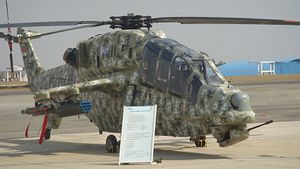A prototype of the Light Combat Helicopter (LCH), currently under development by Hindustan Aeronautics Limited (HAL) for the Indian Army (IA) and Indian Air Force (IAF) will conduct weapons trials in July and August, Indian Minister of State for Defense Rao Inderjit Singh told the Indian Parliament in a written statement this week.
“The certification firing trials with integration of mission sensors such as electro optical system, helmet pointing system and weapon systems air to air missiles, turret gun and rockets are planned during July-August 2016,” the statement reads.
The LCH successfully fired 70 millimeter rockets during this year’s “Iron Fist” military exercise held in March in the Thar Desert in Pokhran, Rajasthan in northwestern India. “The flight trials were successful with respect to system integration, structural integrity, noise and vibration, functionality of system and safe separation of rockets,” Singh elaborates in his statement.
Four LCH prototypes are currently undergoing flight trials, according to HAL. The LCH technology demonstrator completed hot and high altitude trials in September, hot weather flight trials in June, and cold weather flight tests in February, 2015.
As I reported previously (See: “What’s the Status of India’s Light Combat Helicopter?”):
The LCH, which made its maiden flight in May 2010, has been specifically developed in response to the lack of an attack helicopter capable of performing high-altitude operations during the 1999 Kargil War. Consequently, the LCH, a derivative of the HAL Dhruv helicopter, has been primarily designed for high-altitude warfare–HAL and French engine-maker, Turbomeca jointly designed a special engine optimized for extreme altitudes–and has an operational ceiling limit of 6,000–6,500 meters (19,700–21,300 feet).
The twin-engine 5.8-ton LCH is a multipurpose weapons platform and can be used against enemy tanks, armored personnel carriers, slow-moving aircraft, surface warships and even submarines. The LCH can also be deployed in search and rescue missions and battlefield surveillance.
It can be fitted with a variety of different weapon systems, as I explained in an earlier piece:
The armored attack helicopter’s weapon suite includes a 20 millimeter French Giat-Nexter turret gun, four Belgium-made 70 mm anti-tank guided missiles (or, once operational, the Indian Helina anti-tank missile, which is still in development) and MBDA Mistral-2 air-to-air missiles. SAAB South Africa is providing the LCH’s electronic warfare suite.
The Indian Army’s Army Aviation Corps (AAC) has ordered 114 helicopters and the IAF 65. The number of helicopters in the AAC is currently only at 73 percent of its authorized strengths, according to Indian Defense Minister Manohar Parrikar. From 2013-2015, the AAC has lost a total of six helicopters in accidents.
































